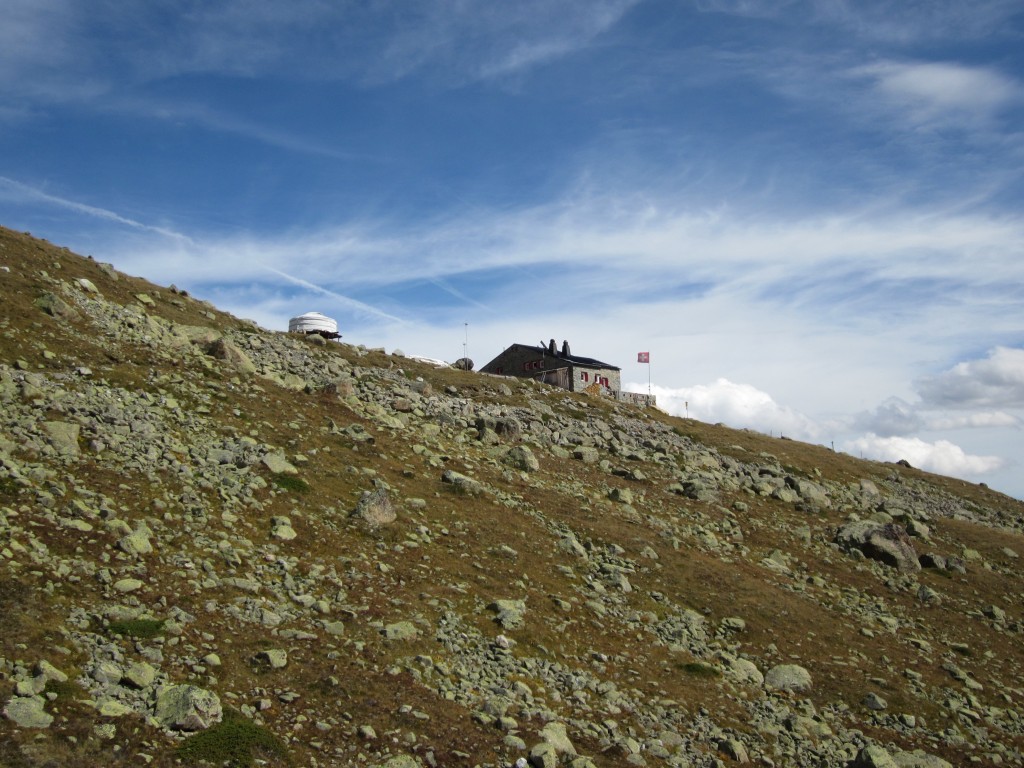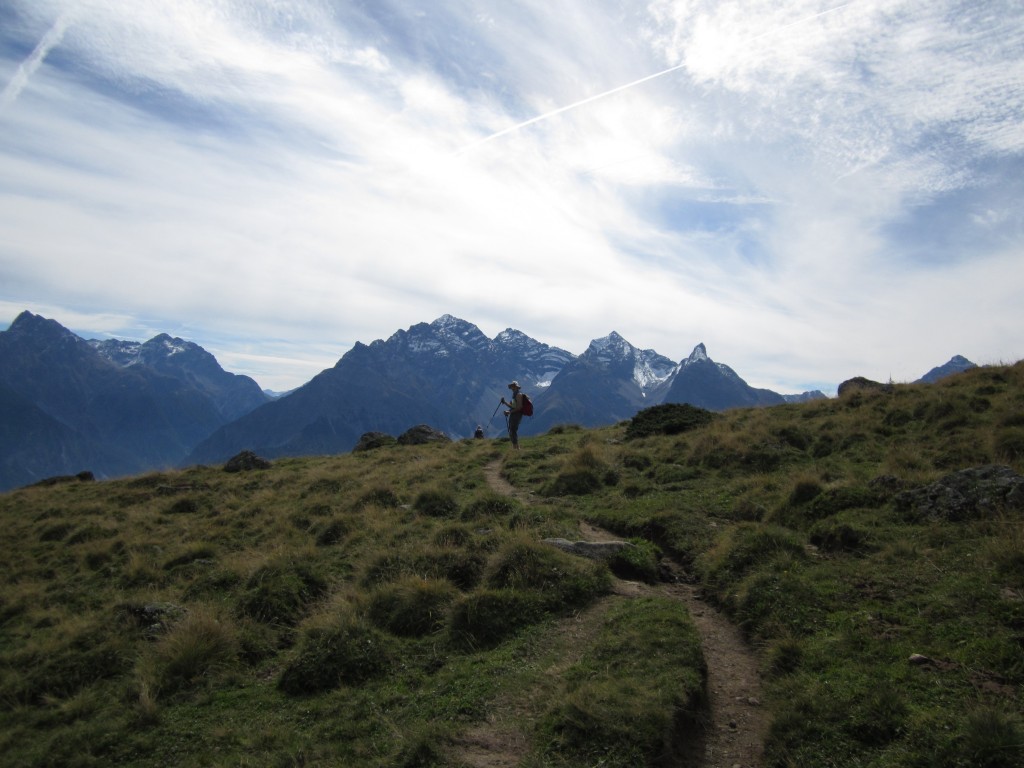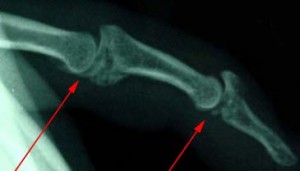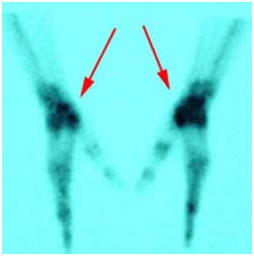Gentle Reader,
The 3rd and most dramatic day of my hiking-in-the-Alps adventure this past Sept. occurred on day 5. Pedie Jolly and I left the other two hikers at the Via Engadina junction above Grevasalvas where they would pass the “Heidi” house.  We trudged on up beyond the tree line to a high lake just below a dramatic escarpment, at 8261 ft. The trail was far more exposed than anticipated with shear drops to the left of us and uneven boulders to climb over. We were both dangling our hiking sticks from the left hand while clinging to rocky outcroppings with the right. There was no looking down. It reminded me of climbing Mt. Shasta in 2006 when my right foot crampons had only the inside 5 spikes engaged with the icy ground and I steadied myself with a well planted ice axe. Even a thin line of grass along the outside edge of the trail made me feel as though I would arrive safely at the lake. It was an opportunity to study my mind and how just a bit of green changes fear to a sense of security. Pedie and I were thrilled to arrive at this lake, hike in a moonscape, where two or three others were already having their lunch.
We trudged on up beyond the tree line to a high lake just below a dramatic escarpment, at 8261 ft. The trail was far more exposed than anticipated with shear drops to the left of us and uneven boulders to climb over. We were both dangling our hiking sticks from the left hand while clinging to rocky outcroppings with the right. There was no looking down. It reminded me of climbing Mt. Shasta in 2006 when my right foot crampons had only the inside 5 spikes engaged with the icy ground and I steadied myself with a well planted ice axe. Even a thin line of grass along the outside edge of the trail made me feel as though I would arrive safely at the lake. It was an opportunity to study my mind and how just a bit of green changes fear to a sense of security. Pedie and I were thrilled to arrive at this lake, hike in a moonscape, where two or three others were already having their lunch. 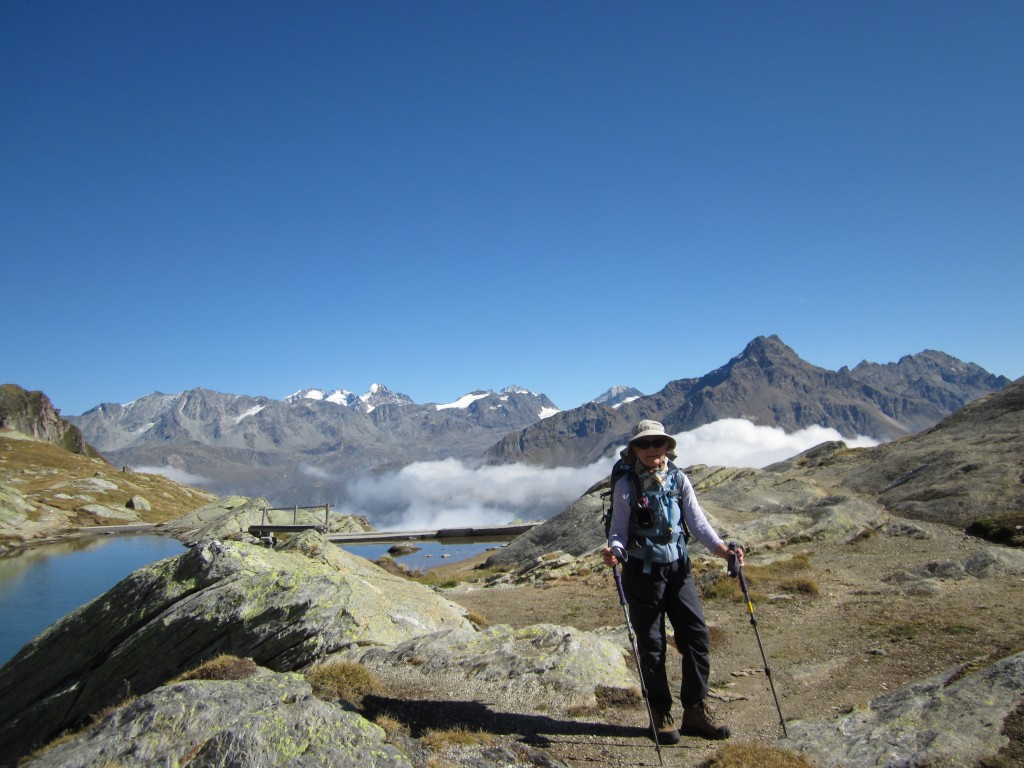
The lake at the Lunghin Pass, above Maloja, is part of the most notable triple watershed in western Europe, from where the Inn (Engadin Valley where we hiked) flows via the Danube to the Black Sea, the Maira via the Po to the Mediterranean Sea, and the Julia via the Rhine to the North Sea. Depending on which direction we emptied our water bottles, those droplets may have run north, south or east, something too grand to envision.
Finding the way over a knoll and down was tricky and the path was slick with thick frost anywhere the sun had not reached.  It was already 2:30 in the afternoon and we still had the entire descent to accomplish. The view was breathtaking, and for one moment, I lost my focus on my feet. The trail was steeply downhill, wet and covered with schist, extremely slippery. Down I went, putting my right hand out to catch myself. Instantly I knew I had hurt my wrist. The fingers and thumb still functioned but pain shot up my arm when I put any pressure on my hiking stick. I collapsed it and stuck it in my pack. Pedie, walking behind me, and I had a 1000 ft drop in 2 miles. It was slow going.
It was already 2:30 in the afternoon and we still had the entire descent to accomplish. The view was breathtaking, and for one moment, I lost my focus on my feet. The trail was steeply downhill, wet and covered with schist, extremely slippery. Down I went, putting my right hand out to catch myself. Instantly I knew I had hurt my wrist. The fingers and thumb still functioned but pain shot up my arm when I put any pressure on my hiking stick. I collapsed it and stuck it in my pack. Pedie, walking behind me, and I had a 1000 ft drop in 2 miles. It was slow going.
We caught a bus to our hotel in Sils Maria whereupon a driver took me immediately to St. Moritz, the glitzy place we’d been avoiding. It was 5:30 on a Friday. No problem for this emergency clinic used to mountain injuries. After several x-rays, an examination and lengthy discussion of two young doctors, they decided to cast my arm. Neither the x-ray tech nor I thought I had broken anything, but I was glad to have protection for the last day of hiking and all the hauling of luggage on and off trains over the next 5 days. Here I am with my bright red cast riding the train to Pontresina at the end of our hike.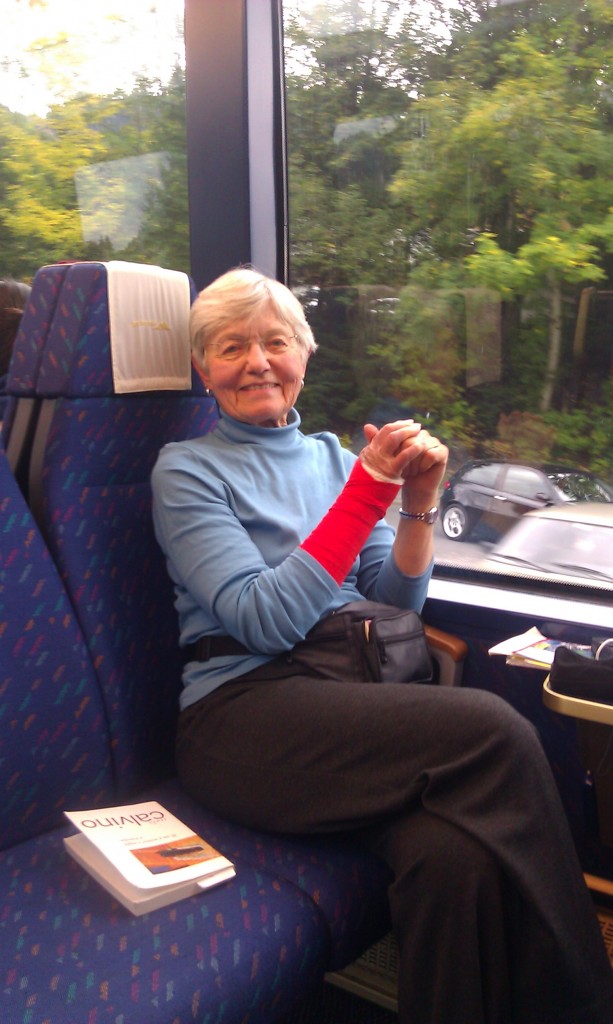
The final day of hiking was in the Italian speaking part of Switzerland along a contour trail with many slippery, water soaked ups and downs assisted by chains or hand rails. I couldn’t use them as they were all positioned for the right arm. My right arm was cradled in a sling. I was relieved to climb over the last of the tree roots, climb the last rocky stretch and walk into the most beautiful, remote high mountain village we’d been in yet: Soglio.  A long soak in the hot bath revived me. Cold beer and good food gave a sense of triumph. We had made it, a 50 mile walk in 6 days from the lower Engadine River to its headwaters and then down the other side.
A long soak in the hot bath revived me. Cold beer and good food gave a sense of triumph. We had made it, a 50 mile walk in 6 days from the lower Engadine River to its headwaters and then down the other side.
Our bus ride back to the starting point took a couple hours. We could spot the ending and beginning points of each day’s hike as we retraced our steps to Pontresina.
What does one do when injured hiking? Keep moving. Get the injured limb as comfortable as possible. Find a skilled clinic. The x-ray tech in St. Moritz told me she does 6-8 of these castings a day in the ski season. She knew what she was doing. I had travel insurance and have filed my claim. The clinic visit was $1000. I took plenty of my herbal pain relieve and really didn’t suffer much. By the time I got to the Villa Lina north of Rome 5 days later, I took off the cast and participated fully in the writers’ workshop for the week.
Will I have arthritis in this wrist? Possibly. Just like any joint injury, trauma creates structural stress and one is likely to pay the price with increased arthritis in the future. I am using this right hand, wrist and arm fully, noting any twinges and backing off when necessary. The osteoarthritis I deal with doesn’t seem any worse. In fact it is only on the days that I don’t get out and walk that I have pain.
I hope you’ve enjoyed the hike stories and will share yours with my readers. Have old injuries come up to haunt you? What are you doing to stay limber and keep moving? Take a minute to leave a comment. Come on over to Face Book and friend me, www.facebook.com/betsyjbell. Sign up to get the next posts. I have some great new research from Johns Hopkins about knee replacement to share with you next week. You won’t want to miss it.
Fondly, Betsy
Be Well, Do Well and Keep Moving
BetsyBell’s Health4u
206 933 1889 1 888 283 2077
betsy@hihohealth.com

